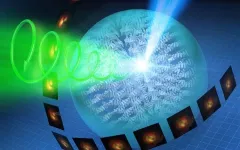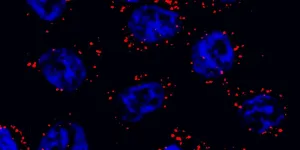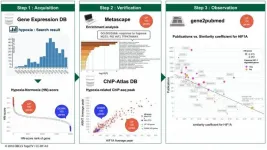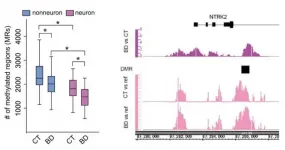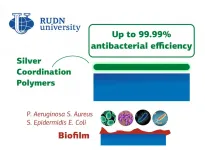INFORMATION:
Astronomers discover a 'changing-look' blazar
2021-06-09
(Press-News.org) A University of Oklahoma doctoral student, graduate and undergraduate research assistants, and an associate professor in the Homer L. Dodge Department of Physics and Astronomy in the University of Oklahoma College of Arts and Sciences are lead authors on a paper describing a "changing-look" blazar - a powerful active galactic nucleus powered by supermassive blackhole at the center of a galaxy. The paper is published in The Astrophysical Journal.
Hora D. Mishra, a Ph.D. student, and faculty member Xinyu Dai are lead authors of the paper, along with Christopher Kochanek and Kris Stanek at the Ohio State University and Ben Shappee at the University of Hawaii. The paper represents the findings of researchers from 12 different institutions who participated in a two-year collaborative project involving the collection of spectra or imaging data in different electromagnetic bands. The OU team led the effort in analyzing all the data collected from the collaboration and contributed primarily on the interpretation of the analysis results, assisted by OU graduate student Saloni Bhatiani and undergraduate students Cora DeFrancesco and John Cox who performed ancillary analyses to the project.
Blazars, explains Mishra, who also serves as president of Lunar Sooners, appear as parallel rays of light or particles, or jets, pointing to observers and radiating across all wavelengths of the electromagnetic spectrum. These jets span distances on the million light-year scales and are known to impact the evolution of the galaxy and galaxy cluster in which they reside via the radiation. These features make blazars ideal environments in which to study the physics of jets and their role in galaxy evolution.
"Blazars are a unique kind of AGN with very powerful jets," she said. "Jets are a radio mode of feedback and because of their scales, they penetrate the galaxy into their large-scale environment. The origin of these jets and processes driving the radiation are not well-known. Thus, studying blazars allows us to understand these jets better and how they are connected to other components of the AGN, like the accretion disk. These jets can heat up and displace gas in their environment affecting, for example, the star formation in the galaxy."
The team's paper highlights the results of a campaign to investigate the evolution of a blazar known as B2 1420+32. At the end of 2017, this blazar exhibited a huge optical flare, a phenomenon captured by the All Sky Automated Survey for SuperNovae telescope network.
"We followed this up by observing the evolution of its spectrum and light curve over the next two years and also retrieved archival data available for this object," Mishra said. "The campaign, with data spanning over a decade, has yielded some most exciting results. We see dramatic variability in the spectrum and multiple transformations between the two blazar sub-classes for the first time for a blazar, thus giving it the name 'changing-look' blazar."
The team concluded that this behavior is caused by the dramatic continuum flux changes, which confirm a long-proposed theory that separates blazars into two major categories.
"In addition, we see several very large multiband flares in the optical and gamma-ray bands on different timescales and new spectral features," Mishra said. "Such extreme variability and the spectral features demand dedicated searches for more such blazars, which will allow us to utilize the dramatic spectral changes observed to reveal AGN/jet physics, including how dust particles around supermassive black holes are destructed by the tremendous radiation from the central engine and how energy from a relativistic jet is transferred into the dust clouds, providing a new channel linking the evolution of the supermassive black hole with its host galaxy."
"We are very excited by the results of discovering a changing-look blazar that transforms itself not once, but three times, between its two sub-classes, from the dramatic changes in its continuum emission," she added. "In addition, we see new spectral features and optical variability that is unprecedented. These results open the door to more such studies of highly variable blazars and their importance in understanding AGN physics."
"It is really interesting to see the emergence of a forest of Iron emission lines, suggesting that nearby dust particles were evaporated by the strong radiation from the jet and released free Iron ions into the emitting clouds, a phenomenon predicted by theoretical models and confirmed in this blazar outburst," Dai said.
ELSE PRESS RELEASES FROM THIS DATE:
Single-particle studies point the way toward next-generation light displays
2021-06-09
Tsukuba, Japan - Holographic displays help add a three-dimensional--and thus more life-like--feel to what would otherwise appear as a two-dimensional image. Now, researchers in Japan have tested how this may work on a supramolecular level; such tests could lead to improved displays.
Commonly, one cannot overlay a certain type of molecular component that underlies helically arranged liquid crystals onto their molecular mirror images, much like a person cannot overlay their two hands and have them match up exactly without flipping one over. Molecules with this property are described as "chiral." Some materials make use of the principle of chirality to rotate light in a plane perpendicular to the direction of the light wave, known as circular ...
New processes for automated fabrication of fiber and silicone composite structures for soft robotics
2021-06-09
Researchers from the Singapore University of Technology and Design (SUTD) have developed novel techniques, known as Automated Fibre Embedding (AFE), to produce complex fibre and silicone composite structures for soft robotics applications. Their work was published in IEEE Robotics and Automation Letters.
Many soft robot components, including sensors and actuators, utilise embedded continuous fibres within elastomeric substrates to achieve various functionalities. However, manual embedding of continuous fibres in soft substrates is challenging due to the complexities involved in handling precise layering, and ...
Turning the heat on: A flexible device for localized heat treatment of living tissues
2021-06-09
Thermotherapy or heat treatment can help in treating lesions and other tissue injuries. For example, chemotherapy or radiotherapy, when combined with thermotherapy, kills tumorous cells more effectively. Thermotherapy is considered a promising approach for treating internal lesions, but the advancement in the field depends on the availability of patient-friendly heat-inducing devices capable of rapidly increasing the temperature of target tissues.
Current clinical practices around thermotherapy majorly employ heat-generating devices that are probed inside ...
Not just a phase for RNAS
2021-06-09
DALLAS - June 9, 2021 - A phenomenon in which an RNA named NORAD drives a protein named Pumilio to form liquid droplets in cells, much like oil in water, appears to tightly regulate the activity of Pumilio. A new study led by UT Southwestern scientists suggests that such RNA-driven "phase separation," in turn, protects against genome instability, premature aging, and neurodegenerative diseases, and may represent a previously unrecognized way for RNAs to regulate cellular processes.
"It's becoming more and more clear that phase separation is an important organizing ...
New study presents tip-induced nano-engineering of strain, bandgap, and exciton funneling in 2D semiconductors
2021-06-09
A research team, led by Professor Kyoung-Duck Park in the Department of Physics at UNIST has succeeded in investigating and controlling the physical properties of naturally-formed nanoscale wrinkles in two-dimensional (2D) semiconductors. This is thanks to their previously-developed hyperspectral adaptive tip-enhanced photoluminescence (a-TEPL) spectroscopy. This will be a major step forward in developing paper-thin, ultra-flexible displays.
Wrinkles are an inevitable structural deformation in 2D semiconductor materials, which gives rise to spatial heterogeneity in material properties, according to the research team. Such structural deformation has long been considered one of the top technical challenges in semiconductor manufacturing, as this would harm the uniformity ...
Artificial light harming clownfish
2021-06-09
Young clownfish living closest to shore are dying faster than those further offshore because they are being exposed to artificial lighting, says an international research team.
Working on the reefs around Moorea in French Polynesia, scientists from France, the United Kingdom, Chile and Australia found that nearshore juvenile clownfish living in anemones under lights had higher mortality than juveniles in anemones not exposed to artificial light.
The scientists also found that the surviving clownfish grew 44 per cent more slowly than clownfish under natural lighting conditions.
Professor Stephen Swearer, a marine ecologist, from the University of Melbourne, ...
Scientists use public databases to leap over scourge of publication bias
2021-06-09
Scientists have leapt over the emerging problem of publication bias within genetic research by performing a meta-analysis of publicly available databases of 'transcriptomes', or the full range of messenger RNA molecules produced by an organism. Researchers from Hiroshima University applied the technique to their own field--the study of the genes that are activated when an organism experiences low-oxygen conditions--but it should also be applicable in any other fields that make use of the transcriptome, providing a powerful weapon against the threat posed by publication bias.
The meta-analysis technique ...
DNA methylation changes and characteristics in neurons of bipolar disorder patients
2021-06-09
A research collaboration based in Kumamoto University, Japan has revealed the DNA methylation status of gene transcriptional regulatory regions in the frontal lobes of patients with bipolar disorder (BD). The regions with altered DNA methylation status were significantly enriched in genomic regions which were reported to be genetically related to BD. These findings are expected to advance the understanding of the pathogenesis of BD and the development of therapeutic drugs targeting epigenetic conditions.
BD is a mental disorder that affects about 1% of the population and requires long-term treatment. Epidemiological studies have ...
RUDN University chemist created coordination polymers with up to 99.99% antibacterial efficiency
2021-06-09
RUDN University chemist with his colleagues from Portugal has developed two types of coating based on new coordination polymers with silver. Both compounds were successfully tested against four common pathogens. The results are published in ACS Publications (ACS Appl. Mater. Interfaces).
Due to the rapid mutation, harmful microorganisms constantly adapt to new antibiotics and antiseptics. It is especially difficult to destroy bacteria when they form a biofilm. They stick together and create a community ready to fight antimicrobial agents back. Coordination polymers (scaffolds made of metal ions and organic ligands) can solve this problem. They prevent pathogens from ...
Researchers reveal relationship between magnetic field and supercapacitors
2021-06-09
Since energy storage devices are often used in a magnetic field environment, scientists have often explored how an external magnetic field affects the charge storage of nonmagnetic aqueous carbon-based supercapacitor systems.
Recently, an experiment designed by Prof. YAN Xingbin's group from the Lanzhou Institute of Chemical Physics (LICP) of the Chinese Academy of Sciences has revealed that applying an external magnetic field can induce capacitance change in aqueous acidic and alkaline electrolytes, but not in neutral electrolytes. The experiment also shows that the force field can explain the origin of the magnetic field effect.
This new discovery establishes ...

